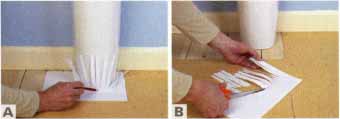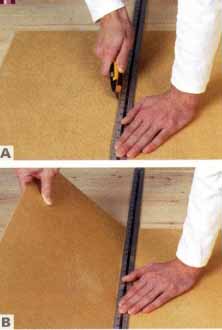A subfloor provides the base for a floor covering. It is applied over the main floor structure, which is typically joists. In some cases codes may allow the floor structure to provide the necessary base for a floor covering. The most common subfloors are made of plywood. Self-leveling compound is used on concrete floors.
Choosing a Subfloor
Existing floor |
Suitable subfloor |
Suitable flooring |
Wood |
3/4 in plywood |
Hard tiles |
Wood |
3/4 in plywood |
Soft tiles |
Wood |
Uncoated plywood |
Soft tiles, or clip-together flooring |
Wood |
Plywood or OSB |
Carpet, or vinyl sheet, or floating wooden floor |
Concrete |
3/4 in plywood or 2 x 4’s |
Any material |
Laying a Sub-floor for a Wooden Floor
There are two options for a wooden floor: plywood and OSB. The information below will help you to choose the most suitable for your needs. A subfloor may raise a floor’s height and stop a door opening smoothly. Do not trim a door until after you lay flooring. It may be possible to hide a slight step between rooms with a threshold strip.
Choosing to use Plywood
Use thick plywood as a subfloor for hard tiles, and thinner plywood to provide a smooth surface for soft floor coverings such as vinyl, carpet, and soft tiles. Large sheets are ideal for large rooms, because they cover the surface quickly and with fewer joints. The order in which boards are nailed down isn't important, except that joints between rows of plywood should be staggered to avoid long joints.
Making a Template For Cuts
Make a paper template of any complicated areas, and trace a guide line along which to cut. Use a sheet of paper cut to size, positioned exactly where the board will be placed. Use a jigsaw to cut the sheets.

A. Cut slits along the edges of a sheet of paper. Press these slits against the obstacle, and crease them sharply around its shape.
B. Cut along the creases to create a template. Lay the paper on a board, use the cut edge to draw a guide line, and cut along the line.
Laying plywood
Decide what type of floor covering you wish to use before laying plywood, because stability and compatibility for the type of floor covering that will be stuck down (vinyl tiles, for example) is essential. Before buying plywood, check that it's suitable as a subfloor. If it isn't , it may expand or contract, depending on humidity, leading to lumps and bumps in the floor. To avoid unevenness, ensure that the plywood is securely screwed down. Plywood is available in large sheets, at a standard size of 4 x 8 ft (1.2 x 2.4 m). Use a jigsaw for a curved cut, and make straight cuts as shown below.
Cutting 1/4 inch Luan Plywood

A. To cut a straight line in luan plywood, first use a utility knife to score the smooth side of the board. Take care not to let the blade slip.
B. Turn the board over, and lay a straight edge (such as a metal ruler) along the scored line. Snap the board along the scored line. Separate the two pieces and neaten the cut edge with a utility knife.
Laying A Subfloor For A Concrete Floor
Self-leveling compound is a latex-based product that provides a very smooth subfloor. It is needed only if a concrete floor is in poor condition. Despite the name, some smoothing is needed for the best surface. The floor may be raised by the subfloor and flooring, so you may need to trim the lower edge of a door after laying flooring.
Preparing the surface
Thoroughly clean the floor. Do not lay compound over any residual bitumen-based products from a previous covering. Prime a dusty surface. Attach a threshold strip across the doorway so that compound does not run into the next room.
Mixing the compound
Use a spotlessly clean bucket, because any impurities will affect the mix’s integrity, and use a power stirrer to mix slowly, to avoid introducing too much air. Self-leveling compound sets relatively quickly, and will remain workable for no more than 30 minutes. Follow the steps shown for one bucket-load, and immediately mix and lay the next bucket while the wet edge is still workable. The coverage from a bag of compound depends on how thickly it's laid.